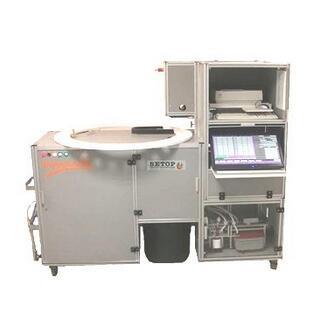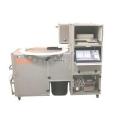方案详情
文
浅表烫伤是苹果在冷藏过程中发生的一种生理性疾病,造成了巨大的市场损失。2012年商品化的抗赤霉病和抗火疫病新品种Ladina,表现出与贮藏后浅表烫伤相似的生理障碍。在这里,我们使用不同的采前和采后方法来描述这些浅表烫伤症状的发生。在7年的时间里,对多个果园的果实进行了5-7个月的贮藏,并对冷藏和气调贮藏后果实表面烫伤的发生情况进行了评估。同一年内不同成熟期采摘的苹果在浅表烫伤发育过程中脱落。此外,浅表烫伤在不同年份和地点间的差异显著,强烈表明收获成熟度、生长季节的天气和果园管理对烫伤的发生起着重要作用。采后用1-甲基环丙烯(1-MCP)处理,在动态控制气氛(DCA)下贮藏,可显著减少浅表烫伤的发生,而超低氧浓度(ULO)下贮藏则表现出轻微但不显著的效果。果肉和果皮中的低钙浓度与较严重的浅表烫伤有关。
方案详情

agronomy 2 of 13Agronomy 2020,10,464 Agronomy 2020, 10, 464; doi:10.3390/agronomy10040464www.mdpi.com/journal/agronomy Article Pre- and Postharvest Factors Control the DiseaseIncidence of Superficial Scald in the New Fire BlightTolerant Apple Variety“Ladina" Laura Juliana Dallenbach 1, Thomas Eppler2, Simone Buihlmann-Schiitz 1, Markus Kellerhals 1and Andreas Bihlmann 2,* 1 Agroscope, Strategic Research Division Plant Breeding, Muller-Thurgaustr 29, CH-8820 Wadenswil,Switzerland;laura.daellenbach@bluewin.ch (L.J.D.); simone.buehlmann-schuetz@agroscope.admin.ch (S.B.-S.); markus.kellerhals@agroscope.admin.ch (M.K.)2 Agroscope, Competence Division Plants and Plant Products,Muller-Thurgaustr 29, CH-8820 Wadenswil,Switzerland; thomas.eppler@agroscope.admin.ch Correspondence: andreas.buehlmann@agroscope.admin.ch; Tel.: +41-58-460-64-24; Fax: +41-58-460-63-41 Received: 11 February 2020; Accepted: 22 March 2020; Published: 27 March 2020 Abstract: Superficial scald is a physiological disorder that develops during cold storage affectingapples and causes substantial market losses. Malus x domestica cv. Ladina, a new scab resistantand fire blight tolerant variety, commercialized in 2012, shows a physiological disorder similar tosuperficial scald after storage. Here, we used different pre- and postharvest approaches to characterizethe occurrence of these superficial scald symptoms in Malus x domestica cv. Ladina. Over a period ofseven years, fruits from multiple orchards were stored for five to seven months and the occurrence ofsuperficial scald was assessed in fruits after cold storage and controlled atmosphere (CA) storage.Apples picked at different stages of ripeness within the same year differed in superficial scalddevelopment. Additionally, superficial scald differed significantly between years and locations,strongly suggesting that maturity at harvest, weather during the growing season, and orchardmanagement play important roles in scald occurrence. Treatment with 1-methylcyclopropene(1-MCP)after harvest, and storage in a dynamically controlled atmosphere (DCA) significantly reduced theoccurrence of superficial scald, whereas storage under ultralow oxygen concentrations (ULO) showedmild but not significant effects. Low calcium concentrations in the fruit flesh and peel were associatedwith stronger superficial scald occurrence. Keywords: apple variety; storage; physiological disorder; dynamic controlled atmosphere storage;1-methylcyclopropene treatment; ultralow oxygen storage; X-ray fluorescence 1. Introduction Malus x domestica cv. Ladina, a new variety, originated from a cross between Malus x domesticacv. Topaz and Malus x domestica cv. Fuji performed in 1999 at Agroscope in Wadenswil, Switzerland,and was first commercialized in 2012 [1]. Ladina has been selected as cultivar because of its geneticresistance against apple scab (Venturia inaequalis, Rui6 resistance) and low susceptibility towardspowdery mildew. Meanwhile, the variety Malus × domestica cv. Ladina has been successfully screenedfor its low susceptibility against fire blight (Erwina amylovora) in shoot and flower inoculation tests in theglasshouse and orchards, respectively[2], increasing its potential for use in organic apple productionsystems. However, concern has arisen as Malus × domestica cv. Ladina has shown a considerableamount of superficial scald after a few months of storage (Figure 1). Figure 1. Superficial scald on Malus x domestica cv. Ladina. Examples of superficial scald in applevariety Malus x domestica cv. Ladina in increasing degrees from left to right occurring after a storageperiod of more than three months and especially during the shelf life at 20 C. Other physiological disorders such as core flush and soft scald have rarely been observed andthe variety is robust against fungal storage diseases such as grey mold (Botrytis cinerea), lenticel rots(Neofabraea spp.), and storage scab (Venturia inaequalis) (data not shown). Therefore, the amount ofsuperficial scald is the only significant postharvest disorder, making it an important problem to manageunder commercial production and marketing settings. Superficial scald is a serious physiological disorder affecting apples and pears. This postharvestdisorder develops after several months of cold storage and increases after removal from storage,causing a substantial loss of market value [3,4]. Symptoms appear as darkened areas on the peeland primarily affect the peel forming epidermis and hypodermis, with parenchymal layers rarelyaffected [5]. Susceptibility to superficial scald varies greatly by cultivar, climate, ripening stage, culturalpractices, and postharvest conditions [6,7]. Despite intensive investigation, the biochemical mechanismsunderlying superficial scald development remain largely unknown [3,8]. Superficial scald has beendescribed as a special case of chilling injury induced by oxidative stress on secondary metabolites [9].The oxidation products of c-farnesene include conjugated trienes [6,9] and 6-methyl-5-hepten-2-one [10],which seem to be more directly associated with superficial scald development than c-farnesene itself [11].Furthermore, the synthesis of c-farnesene has been shown to be positively influenced by the ripeninghormone ethylene, and hence ripening facilitates superficial scald development [12-14]. the skin and the fruit flesh [26]. Additionally, potassium has been shown to antagonize calcium uptakeinto the leaves, thus, lowering total calcium concentrations which indicates that there are possibleinteractions between these two minerals [27]. The objective of the present study was to characterize the influence of various pre- and postharvestfactors on the incidence of superficial scald development on Malus x domestica cv. Ladina. Thesefactors included (i) the duration of the storage period; (ii) preharvest factors such as varying growingseasons, orchard locations, and harvest dates; (iii) storage under ultralow oxygen conditions (ULO),DCA storage, and 1-MCP treatment; and (iv) potassium and calcium concentrations and their ratios inthe apple fruits and skin. 2. Materials and Methods Storage experiments of Malus x domestica cv. Ladina were conducted at Agroscope Wadenswil,Switzerland in research sized storage facilities with fruits from six consecutive growing seasons from2013 to 2018. Fruits used for the trials originated from various locations and growers, and differentorchards within locations. GPS data for the orchards are as follows: Wadenswil,WA (plots Wa64and Wa66 47°13'15"N,8°40'01"E, Wa39 47°13'27"'N,8°40'37"E), Guttingen, GU (Gu53 47°36'07"'N, 9°16'37"E), Wiilflingen, WU (47°30'50"N,8°42'00"E), Blidegg-Bischofszell, BI (47°30'09"N,9°14'18"E), and Morges-Marcelin, MA (46°31'08"'N, 6°29'02"E). Fruits from WA, GU, WU, andMA were treated with a standardized plant protection strategy representative for Swiss IntegratedPest Management while fruits from BI were treated under a Swiss organic management system.Fruits were stored in a cold store at 1°C until further storage under the appropriate storage conditions.On average, fruits were stored in cold storage for 9 days before treatments started, however, nevermore than 23 days. To control for ripeness, basic apple quality parameters (i.e., firmness (kg/cm2) usinga penetrometer equipped with a 11 mm punch and sugar content (° brix) using a refractometer perfruit plus acidity (titration) as a mean of 10 fruits) were assessed on the "Pimprenelle" machine (SetopGiraud Technology, Cavaillon, France) and the starch index was assessed visually prior to storage (datanot shown). Afterwards, fruits were stored for 5 to 7 months before removal from storage. Basic applequality parameters (firmness, total soluble solids (TSS), acidity) were measured immediately afterremoval from storage and again after 7 days of "shelf life" at 20 °C. Storage disorders and diseases of20 fruits were visually assessed immediately after removal from cold store and after 7 days of "shelflife" at 20°C. Exact harvest dates and dates of storage removal are specified (Table 1). Standard controlled atmosphere (CA)conditions were set to 1℃,1%CO2,1%O2, and 92% relativehumidity. Additionally, variations to these conditions were added with the application of 1-MCP(Agrofresh,Philadelphia, PA, USA) in 2013 and 2014 (only to fruits from Wiilflingen), the applicationof ultralow oxygen storage at 0.5% in 2014, and storage under dynamic controlled atmosphere (DCA)by measuring chlorophyll-a fluorescence using Harvest Watch sensors (DeLong et al., 2004) in 2017.Additionally, fruits were harvested at two different ripeness degrees in 2014 and at three differentripeness degrees in 2015 (Table 1). Potassium and calcium concentrations and their ratio K/Ca were measured as suggested bythe manufacturer of the atomic absorption spectrometer. Briefly, ten apples per sample were eachdivided into ten pieces. Four pieces of each apple were weighed, dried at 70 °C for 2 days, andground. Then, 250 mg of fruit powder was dissolved in 4 mL nitric acid (69%). After 10 min, 3.5 mLhydrogen peroxide (30%) was added. After another 15 min, samples were digested in a microwaveoven MLS-EM2, (Milestone, Sorisole,Italy). The K/Ca content of each sample was determined usingan atomic absorption spectrometer (AAS) iCE3000 (Thermo Fisher, Waltham, MA, USA). Results wereconverted into mg/100 g fresh fruit. For the fruits of the 2018 growing season, the incidence of superficial scald was quantified usingan automatic iQS quality sorting system mounted on a small industrial scale fruit-sorting machine.Additionally, the disease incidence was scored visually on a scale from 1 to 5 and by calculating thepercentage of fruits with disease per plot/orchard. The K/Ca content measured using X-ray fluorescence analysis was performed on a CTX CounterTop XRF (Bruker, Berlin, DE) according to the instructions ofthe manufacturer. Fruits were placed on the measuring platform and mineral contents were measuredusing the fruit quality calibration provided by the manufacturer. Four points along the equator of thefruits were measured per fruit. Table 1. Harvest dates and dates of storage removal of Malus x domestica cv. Ladina apples fromdifferent locations, years, and treatments, including estimated ripeness expressed as Streif index. (Streifindex= firmness (kg/cm²) / (starch degradation (1-10) * total soluble solids (°brix)). Where notindicated otherwise, fruits were stored under controlled atmosphere (CA) conditions at 1°C, 1% CO2,1% O2, and 92% relative humidity (control treatment). Plot Harvest Date Early Removal Late Removal Control Treatment Ripeness Index Wa64 29.09.2013 03.02.2014 29.04.2014 CA 1-MCP 0.117 Wa66 01.10.2013 03.02.2014 29.04.2014 CA 1-MCP 0.086 Wa64 10.09.2014 18.02.2015 11.05.2015 0.5%O, 0.116 Wa64 22.09.2014 18.02.2015 11.05.2015 0.5%02 0.08 Wa66 10.09.2014 18.02.2015 11.05.2015 0.5%O, 0.111 Wa66 22.09.2014 18.02.2015 11.05.2015 0.5%O, 0.079 Wu 05.09.2014 18.02.2015 11.05.2015 1-MCP 0.097 Wu 13.09.2014 18.02.2015 11.05.2015 1-MCP 0.082 Wa64 10.09.2015 01.02.2016 26.04.2016 CA 0.19 Wa64 15.09.2015 01.02.2016 26.04.2016 NA 0.15 Wa64 06.10.2015 01.02.2016 26.04.2016 NA 0.1 Wa66 10.09.2015 01.02.2016 26.04.2016 NA 0.182 Wa66 15.09.2015 01.02.2016 26.04.2016 NA 0.15 Wa66 06.10.2015 01.02.2016 26.04.2016 NA 0.1 BI 26.09.2016 21.02.2017 12.05.2017 NA 0.145 Gu53 26.09.2016 21.02.2017 12.05.2017 NA 0.105 Ma 22.09.2016 21.02.2017 12.05.2017 NA 0.113 Wu 26.09.2016 21.02.2017 12.05.2017 NA 0.116 BI 12.09.2017 19.02.2018 17.04.2018 DCA Gu53 20.09.2017 19.02.2018 17.04.2018 DCA Wa39 20.09.2017 19.02.2018 17.04.2018 CA DCA 0.099 Gu53 14.09.2018 26.02.2019 09.04.2019 DCA DCA+1-MCP 0.109 Wa39 14.09.2018 26.02.2019 09.04.2019 DCA DCA+1-MCP 0.12 All statistical analyses were conducted using R version 3.5.1 (R Core Team 2018). Analysisof different harvest dates was performed using generalized linear models with a binomial errordistribution. For the analysis of the influence of the growing season on scald incidence, only controltreatments were chosen and analyzed in a generalized linear mixed-effects model (family = binomial)using "lme4" [28] with the occurrence of superficial scald as response variable, growing season as fixedfactor, and plot as random factor. The incidence of postharvest treatment protocols such as ultralowoxygen storage, DCA, 1-MCP, and combined DCA + 1-MCP on superficial scald was compared usinga generalized linear mixed-effects model with a binomial distribution. Treatment, time of removalfrom storage, and harvest date were incorporated as fixed factors, whereas plot was incorporated asa random factor. The significance of the fixed factors in all models was analyzed using likelihoodratio tests (LRT) (Chi-squared). A correlation test was performed on the K/Ca ratio at harvest and theincidence of superficial scald at early and late removal from storage. Furthermore, the K/Ca ratio wascompared between damaged and undamaged fruits using an unpairedt-test. Measurements fromdifferent plots, years, and times of removal from storage were treated as replicates. Significance ofdifferences in calcium and potassium concentrations in the skin and their ratios were tested usingKruskal-Wallis and Dunn post-hoc analyses. 3. Results Immediately after removal from storage, no fruits showed signs of superficial scald. Superficialscald developed only after the fruits were exposed to a shelf life period of seven days at 20°C. In total, overall years and treatments, 17.7% of fruits removed from storage early (February) and 35.5% of fruitsremoved late (April) developed symptoms of superficial scald (Figure 1). In all trials, occurrence of superficial scald was significantly greater, the longer fruits had beenstored. The origin of the fruits showed a significant effect on the incidence of superficial scald (Figure 2a).In 2015, when fruits were harvested at three different ripeness degrees, the harvest date was crucial forthe occurrence of superficial scald, occurring least in fruits that were harvested at the intermediate date(Figure 2b). Occurrence of superficial scald was significantly different between years. Fluctuationswere considerable, with 2014 and 2015 showing low superficial scald incidence, whereas 2013, 2016,and 2017 showing increased occurrence of superficial scald (Figure 2c). a100 Time of removal trom storage O Early removal Late removal Time of removal from storage 0Early removal Late removal Time of removal from storage Early removal Late removal 00 2013 2014 2015 2016 2017 Year Figure 2. Preharvest factors influencing superficial scald development on Malus x domestica cv. Ladina.Percentage of superficial scald occurring in"Ladina" after 7 days "shelf life" at 20°C when removedfrom storage after 5 months (early removal) or after 7 months (late removal). (a) Percentage ofsymptomatic fruits in four locations and two growing seasons (2016 and 2017)); (b) Percentage ofsymptomatic fruits harvested at three different ripening degrees from two orchards in one locationand one growing season (2015); (c) Percentage of symptomatic fruits from different growing seasonswith fruits from all locations (2013 to 2018). All fruits displayed were stored under control conditions.The results of the statistical evaluations are displayed in Table 2. Dots represent measured data pointsand horizontal lines denoting the means. An ultralow oxygen level storage (0.5%O2) slightly but not significantly reduced the occurrenceof superficial scald (Figure 3a). The storage under dynamic controlled atmosphere (DCA) significantlyreduced superficial scald as compared with normal CA storage (Figure 3b), and there was a significantreduction of superficial scald incidence with the application of 1-methylcyclopropene (1-MCP)(Figure 3c). A combined application of 1-MCP and storage in DCA further reduced the occurrence ofsuperficial scald incidence after storage (Figure 3d). All statistical results are in Table 2. Table 2. Results of generalized linear models (family = binomial) comparing the occurrence ofsuperficial scald between various treatments (1-MCP treatment,ultralow oxygen treatment, and DCAtreatment) and the respective control, as well as the comparison between different harvest times, years,and locations within the control treatments, df = degree of freedom. Significance values (p<0.05) forfixed effects were determined using LRT (Chi-squared) and are listed below in bold. Treatment Factor df LRT (x²) p-value Plot Treatment 3 30 <0.001 Time of removal 1 6.6 0.01 Harvest Date Treatment 2 14.8 <0.001 Time of removal 1 12 <0.001 Year Year 4 27.3 <0.001 Time of removal 1 18.6 <0.001 ULO Treatment 1 1.7 0.202 Time of removal 1 9.6 0.002 DCA Treatment 1 6.6 0.007 Time of removal 1 7.2 0.01 1-MCP Treatment 1 5.8 0.016 Time of removal 1 28.4 <0.001 DCA +1-MCP Treatment 1 14.1 <0.001 Time of removal 1 3.4 0.07 Figure 3. Postharvest factors influencing superficial scald. Percentage of fruits with superficial scaldon Malus × domestica cv. Ladina stored under different storage conditions after 7 days"shelf life" at20°C when removed from storage after 5 months (early removal) or after 7 months (late removal).(a) Ultralow oxygen treatment (2014, two plots, two harvest dates each); (b) Dynamic controlledatmosphere storage (2017, three plots);(c)1-MCP treatment (2013, two plots, two harvest dates each);and (d) combined DCA and 1-MCP treatment (2018, two plots). Dots represent measured data pointsand horizontal lines denoting the means. The measured potassium/calcium (K/Ca) ratio at harvest showed a low correlation with percent ofsuperficial scald at early or late removal from storage (Figure 4a, r²=0.0819). However, the K/Ca ratiosof damaged and undamaged fruits were significantly different from each other (Figure 4b, p=0.004, t =3.176, df = 21.43). Symptomatic fruits showed a significantly higher K/Ca ratio in all plots except inplot BI where the mean K/Ca ratio was higher but not significant. Figure 4. Potassium and calcium (K/Ca) ratios in fruits measured using AAS (atomic absorptionspectroscopy) and correlations to superficial scald development. (a) Mean K/Ca ratio measured byAAS at harvest and percent of fruits with superficial scald at removal from storage showed a very poorcorrelation with r2=0.0819; (b) K/Ca ratio in damaged and undamaged fruits after storage split bylocation, measured by AAS. Blidegg-Bischofszell (BI), Morges-Marcelin (MA), and Wulflingen (WU)were measured in 2016; Wadenswil (WA) in 2017 and 2018; and Gittingen (GU) in 2016, 2017, and 2018.K/Ca ratio was measured twice per plot each year, at two different storage removal dates. Because the measurement of K/Ca concentrations in apples using AAS is labor intensive, the K/Caconcentrations on apples from five different plots were measured using X-ray fluorescence enablinga larger sampling size. The K/Ca ratios differed significantly between plots (Figure 5a). Potassiumlevels differed only slightly across plots (Figure 5b) but calcium levels showed significant differences(Figure 5c) affecting the K/Ca levels. The K/Ca ratios measured using XRF showed much lower valuesas compared with the AAS method, indicating a higher calcium and a lower potassium concentrationin the skin as compared with the apple cortex tissue. Previously, it was shown that the XRF technology has sufficient accuracy and resolution to measurethe distribution of potassium and calcium concentrations throughout single fruits and due to its simplemeasurement principle allows for a much higher sample throughput as compared with AAS [28-30].In order to test this claim and to measure K/Ca ratios more accurately, 20 to 30 fruits from five differentorchards on four points along the equator of the fruits were measured. Thered, sun-exposed side ofthe fruits showed a significantly lower K/Ca ratio and higher calcium concentration as compared withthe green, shade-exposed side of the fruit. The other two sides in between the two extremes showedsimilar intermediate values (Figure 6). Figure 5. Potassium and calcium ratios in fruits measured using X-ray fluorescence (XRF). Mean K/Caratio (a), potassium (b), and calcium (c) concentrations measured using XRF for the trial 2018 to 2019.Letters denote significant differences after Kruskal-Wallis rank sum test and Dunn post-hoc analysisshowing significant differences in calcium concentrations, and thus K/Ca ratios by orchard, whilepotassium values do not differ significantly. Figure 6. Spatial distribution of potassium and calcium ratios along the fruit equator. K/Ca ratio asmeasured on four sides per apple along the equator of the fruits using XRF for the trial 2018 to 2019. Thered, sun-exposed side showed a significantly lower K/Ca ratio as compared with the green side facingthe inside of the tree. The sections in between showed intermediate values. Significant differences inthe K/Ca ratios were caused by significant differences in the calcium concentrations and constant levelsof potassium levels, as already stated above with the different orchards. Letters denote significantdifferences after the Kruskal-Wallis rank sum test and Dunn post-hoc analysis. The mean of superficial scald incidence correlated with the mean K/Ca ratio (r²= 0.635 to 0.741)depending on the type of disorder or disease quantification (Figure 7a-c). However, when plottedindividually a small correlation coefficient r²= 0.113 was measured (Figure 7d). Potassium/calcium ratio Figure 7. Correlations of K/Ca ratios and disease incidence on fruits. Mean K/Ca ratio as measuredon four points across the equator for each fruit by XRF. The mean values per orchard were plottedagainst soft scald incidence measured using an automatic disorder and disease scoring on a commercialgrading machine(a), plotted against superficial scald incidence scored visually by eye on a scale from1 to 5 (b), plotted against percent of symptomatic fruits with superficial scald (c), and plotted foreach single data point using the iQS quality values (d). When grouped by means, a high correlationcoefficient (0.635 to 0.716) could be measured, whereas plotting all single data points showed a lowcorrelation coefficient, indicating a high variability among the single fruits. 4. Discussion In an attempt to characterize the incidence of superficial scald in Malus ×domestica cv. Ladinato a deeper level, the disease incidence for fruits of different orchards, for fruits of different ripenessdegrees harvested at varying harvest dates, and for different years has been monitored in this study. In2014, early harvested fruits from two different orchards at the same location showed a trend towardsdeveloping superficial scald more frequently. Additionally, earlier harvested fruits from a differentgrower developed superficial scald significantly more often, confirming previous studies [7,31] thatsuperficial scald is prone to early harvest dates. In 2015,apples from two different orchards wereharvested at three different ripeness degrees. The different harvest dates significantly influenced thelater occurrence of superficial scald, with the intermediate harvest date inducing the lowest incidenceof superficial scald. Previously, it was speculated that immature apples could have a less efficientantioxidant system which makes them more susceptible towards superficial scald [31]. In a further analysis, superficial scald susceptibility of Ladina apples stored under the samestorage conditions for multiple years (2013 to 2017) were compared. Susceptibility towards superficialscald was significantly greater the longer fruits were stored and differed considerably between years,confirming previous studies showing that the weather conditions during the growing season can greatlyinfluence susceptibility towards physiological disorders such as superficial scald [32]. Compared toother years, fruits that were harvested in 2014 and 2015 showed a very low susceptibility towards superficial scald, indicating that climatic differences between years could play an important role inthe development of superficial scald. The weather conditions in Switzerland, in 2014 and 2015 in thelast six weeks before harvest, showed a high number of hours below 10°C as compared with theother years within this study. This corresponds with the study of [33], where it was shown that applesgrown under warm and dry environmental conditions were generally more prone to superficial scaldthan apples that were grown in cooler climates. Previously, it was shown that susceptibility towardssuperficial scald can be predicted based on the frequency of low temperature exposure in autumn [12]. To decrease severity of superficial scald, different postharvest treatments and storage methodswere tested over several years. Storing fruits under ultralow oxygen conditions showed a mildbut not significant effect on the occurrence of superficial scald, contrary to previous studies [33].The application of 1-MCP significantly reduced superficial scald on fruits (Figure 2a), supporting recentstudies on other varieties [4,11,18], due to 1-MCP being an extremely effective competitive inhibitorof ethylene. Ethylene was shown to influence the content of o-farnesene in apple skin, and thus thedevelopment of superficial scald [18]. The reduction of superficial scald by 1-MCP was observed infruits from all locations except from plot Wa64, where the overall occurrence of superficial scald of over75% was high because fruits had been harvested very late that year (Table 1), and could have missedthe appropriate ripeness degree for 1-MCP application, and thus influenced the results negatively.Dynamic controlled atmosphere storage showed similar results to the 1-MCP treatment (Figure 2b).Fruits from all orchards and growers showed a reduction of superficial scald when stored under DCAconditions as compared with regular CA conditions. These findings are consistent with studies by [34].The reduction of superficial scald by application of 1-MCP or DCA storage suggests that the superficialscald in"Ladina" apples is an ageing problem, previously described as senescent scald [35]. No preharvest condition or postharvest method restrained superficial scald below a limit ofdetection after seven months of storage. Malus x domestica cv. Ladina seems to be a variety particularlysusceptible to superficial scald, as was shown before for Malus x domestica cvs. Granny Smith andRed Delicious. Other cultivars, such as "Golden Delicious" and "Empire"seem to possess a naturalrobustness, suggesting a genetic basis for this particular physiological disorder [33].However, thegenetic reasons for these differences remain to be elucidated. Mineral supply of fruits such as potassium and calcium can be an important precondition andeven a main factor driving the superficial scald development. In this study, mean potassium/calcium(K/Ca) ratio at harvest was not predictive for superficial scald development. In the growing season2017, plots Gu53 and Wa39 showed very similar K/Ca ratios; however, the respective fruits differedextremely in their amount of superficial scald after seven months of storage. Contrarily, the K/Caratio measurements after removal from storage, on damaged and undamaged fruits, showed cleardifferences for all orchards studied. While undamaged fruits had a rather low ratio, damaged fruitsshowed a significantly higher K/Ca ratio. This is in agreement with previous studies, where low calciumand high potassium levels were found to facilitate superficial scald occurrence [21]. This leads to theassumption, that the K/Ca ratio in fruits greatly varies within orchards and possibly even within singletrees. In order to increase sample size, an experiment was performed measuring K/Ca concentrationsusing XRF. This technology allows for a much higher throughput but measures only the top 0.1 mmof the fruit skin (personal communication Bruker). Thus, the K/Ca ratios changed significantly fromvalues of 10 to 40 measured using AAS on ground tissue, to values from 0.5 to 5. The potassium levelsremained relatively constant with a 1.5 to 2 times increase in the skin as compared with the cortex.Calcium concentrations, however, increased by a factor of 10 to 15 indicating that in the majority ofthe fruits, calcium is abundant in much higher concentrations in the epidermis or hypodermis ascompared with the cortex. The mean K/Ca values of the different plots correlated well with the amountof scald development but values from single apples showed a poor correlation. This could reflectthe high variability of the calcium values within different apples and within trees and tree-to-treevariability, and thus would indicate a need for a better understanding of how the calcium distributeswithin the apple skin. Additionally, the results showed that the estimation of superficial scald could be 5.Conclusions The novel scab resistant and fire blight tolerant apple variety Malus x domestica cv. Ladina canproduce a form of superficial scald, which was shown to vary in extent depending on the growingseason and ripeness degree at harvest. Storage under DCA, 1-MCP, and a combination thereof showeda promising reduction in the development of superficial scald. The distribution of potassium, calcium,and its ratio within the skin, but not in dried apple slices showed an effect on the development ofsenescent scald with low calcium values promoting the extent of the disorder. Author Contributions: Conceptualization, M.K. and A.B.; methodology,L.J.D., T.E., S.B.-S., and A.B.; formalanalysis L.J.D. and A.B.; writing-original draft preparation L.J.D.; writing-review and editing S.B.-S., M.K., andA.B. All authors have read and agreed to the published version of the manuscript. Funding: This research received no external funding. Acknowledgments: We thank Bruker Germany and Protun AG Switzerland for providing the XRF machine andassisting with measurements and the fruit growers delivering samples from the various locations of the trials. Conflicts of Interest: The authors declare no conflict of interest. References 1. Leumann, L.; Baumgartner, I.O.; Lussi, L.; Frey, L.; Nolly,M.; Weber, M.; Kellerhals, M. Ladina, die neuefeuerbrandrobuste Apfelsorte. Schweiz. Z. Obst-Und Weinbau 2013,1, 10-13. 2. Baumgartner, I.; Leumann, L.R.; Frey, J.E.; Joos, M.; Voegele, R.T.; Kellerhals,M. Breeding apples to withstandinfection pressure by fire blight and other diseases. In Proceedings of the 15th International Conferenceon Organic Fruit-Growing. Proceedings for the conference, Hohenheim, Germany, 20-22 February 2012;pp. 14-21. ( 3. Whitaker, B.D. Genetic and bi o chemical bases of superficial scald storage disorder in apple and pear fruits.Actahortic 2013, 989, 47-60. [Cro s s R e f ] ) 4. Zanella, A. Control of apple superficial scald and ripening-A comparison between 1-methylcyclopropeneand diphenylamine postharvest treatments, initial low oxygen stress and ultra low oxygen storage. PostharvestBiol. Technol. 2003,27,69-78.[CrossRef ( 5. Bain, J.M.; Mercer, F .V. The submicroscopic cytology of superficial scald, a physiological disease of apples.Aust. J. Biol . Sci . 1963,16,442. [ C rossRef] ) ( 7. Ingle, M.;D'Souza, M.C. Physiology and control of superficial scald of apples: A review. HortScience 19 8 9, 24,28-31. ) ( 8. Whitaker, B.D. Oxidative stress and s u perficial scald of apple fruit. HortScience 2004, 39, 933-937. [ CrossRef] ) ( 9. Huelin, F.E.; Coggiola, I .M. Superficial scald, a functional disorder o f stored apples. V. -Oxidation ofc-farnesene and it s inhibition by diphenylamine. J. Sci. Foo d Agric. 1970, 21, 4 4-48. [Cro s s Ref] ) ( 10. Mir, N.; Perez, R.; Beaudry, R.M. A poststorage burst of 6-Methyl-5-hepten-2-one (MHO) may be related tosuperficial scald development in Cortland'Apples. J. Am. Soc. Hortic . Sci. 1999,124,173-176.[ Cross R ef] ) 11. Fan, X.;Mattheis, J.P.; Blankenship, S. Development of apple superficial scald, soft scald, core flush, andgreasiness is reduced by MCP. J. Agric. Food Chem. 1999,47,3063-3068. [CrossRef] 12. Barden, C.L.; Bramlage, W.J. Accumulation of antioxidants in apple peel as related to preharvest factors andsuperficial scald susceptibility of the fruit. J. Am. Soc. Hortic. Sci. 1994,119,264-269. [CrossRef] 13. Gong, Y.; Tian, M.S. Inhibitory effect of diazocyclopentadiene on the development of superficial scald inGranny Smith apple. Plant Growth Regul. 1998, 26,117-121. [CrossRef] ( 14. Watkins, C.B.; Barden, C.L.;Bramlage, W.J. Relationships between alpha-farnesene, ehtylene p r oduction andsuperficial scald development of apples. Actahortic 1993, 343,155-160. [Cro s s R e f] ) ( 15. Gorny, J.R.; Kader, A.A. Controlled-atmosphere suppression of ACC synthase and ACC oxidase in 'Golden D eliciousapples during lo n g-term cold storage. J. Am. Soc. Ho r tic. Sci. 1996,121,751-755. [Cr o s sRef] ) ( 16. DeLong, J.M.; Prange, R . K.; Harrison, P.A. Chlorophyll fluorescence-based low-O2 CA storage of organic'Cortland'and Delicious' apples. Actahortic 2007, 737, 31-37. [C rossRef] ) ( 17. Sisler, E.C.; Serek, M.;Dupille, E .; Goren, R. Inhibition of ethylene responses by 1-Methylcyclopropene and3-Methylcyclopropene. P l ant Growth Regul. 1999,27, 105-111.[ C r ossRef] ) ( 18. Rupasinghe, H.P.V.; Murr, D.P.; Paliyath, G.; Skog, L. I n hibitory effect of 1-MCP on ripening and superficialscald development i n 'McIntosh'an d ‘Delicious’ apples. J . H o rtic. Sci. Biotechnol. 2 000,75, 2 71-276. C rossRef | ) ( 19. Mditshwa, A.; Fawole,O.A.;Opara, U.L. Recent developments on dynamic controlled atmosphere storage ofapples-A review. Food Packag. Shelf Life 2018, 16,59-68. [Cr ossRef] ) ( 20. Prange, R.K.; Wright, A.H.; D eLong, J.M.; Zanella, A. A Reveiw on the Succesful Adoption of DynamicControlled Atmosphere (DCA) Storage as Areplacement for Diphenylamine (DPA), the Chemical Used forControl of Superficial Scald in Apples and Pears. Actahortic 2015, 1071,389-396. [Cr o s sRef] ) ( 21. Ferguson, I.; Volz, R.; Woolf, A. Preharvest factors affecting physiological disorders of fruit. Postha r vest Biol. Technol. 1999, 15,255-262. [ CrossRef ] ) ( 22. Perring, M.A.; Pearson, K . I ncidence of bitter pit in relation to the calcium content of apples: Calcium distribution in the fruit. J. Sci . Food Agric. 1986,37,709-718. [C r o ssRef] ) ( 23. Demarty, M . ; M o rvan, C.; Thellier, M. Ca l cium and the cell wall. Plan t Cell Envi r on. 1984 , 7, 441-448. [ CrossRef l ) ( 24. Picchioni, G.; Watada, A .; Conway, W.; Whitaker, B. ; Sams, C. Po s tharvest calcium inf i ltration delays membrane lipid ca t abolism in apple fruit. J. Agric. F o od Chem. 19 9 8, 46,2452-2457. [Cro s sRe f] ) ( 25. Picchioni, G.A.;Watada, A.E.;Whitaker, B .D.; Reyes, A. Calcium delays senescence-related membrane lipidchanges and increases net synthesis of membrane lipid components in sh r edded carrot s . Postharvest Biol. Technol. 1996,9,235-245. [ C ro s s R ef] ) ( White, P.J.; Broadley, M.R. Calcium in plants. Ann. Bot. 2003,92,487-511. [C rossRef] ) ( Vang-Petersen, O. Calcium, potassium and magnesium nutrition and their interactions in'Cox’s Orange'apple trees. S ci. Hortic. 1980, 12,1 5 3-161. [C r o ssRef] ) ( 28. Kalcsits, L.A.; van der Heijden, G.; Reid, M.;Mullin, K. Calcium absorption during fruit development in 'Honeycrisp'apple measured using 44Ca as a stable isotope tracer. HortScience 201 7 ,52,1804-1809. [Cros s R ef] ) ( 29. Kalcsits, L.A. Non-destructive measurement of calcium and potassium in apple and pear using handheld X-ray fluorescence. Front. P lant Sci. 2016, 7, 4 42. [ C rossRef] ) ( 30. J . Zuniga, C.E.; Jarolmasjed, S.; Sinha, R. ; Zhang, C.; Kal c sits, L.; Dhingra, A.; Sankaran, S. Spectrometrictechniques for e l emental profile analysis associated with bitter pit i n apples. Postharvest Biol. Technol. 2017, 128,121-129.[C rossR e f] ) ( 31. Anet, E.F.L.J. Superficial scald, a functional disorder of s t ored apples. IX . Ef f ect of maturity and ventilation.J. Sci. Food Agric. 1972, 23,763-769. [C rossRef] ) ( 32. Emongor, V.E.; M u rr, D.P.; Lougheed, E.C. Pre h arvest fact o rs that predispose apples to superficial scald.Postharvest Biol. Technol. 1994,4,289-300. [C rossRef] ) ( 33. Wang, Z.; D illey, D. Control of superficia l scald of apples by low-oxygen atmospheres. HortScience 1999,34, 1145-1151. [ CrossRef] ) 35. Zoffoli, J.P.; Richardson, D.;Chen, P.; Sugar, D. Spectrophotometric characterization of superficial scald andsenescent scald in pear fruits relative to different stages of maturity. Actahortic 1998, 475, 543-558. [CrossRef] 36. Herremans, E.; Melado-Herreros, A.; Defraeye, T; Verlinden, B.; Hertog, M.; Verboven, P.; Val, J.;Fernandez-Valle, M.E.; Bongaers, E.; Estrade, P.; et al. Comparison of X-ray CT and MRI of watercoredisorder of different apple cultivars. Postharvest Biol. Technol. 2014,87,42-50. [CrossRef] 37. Herremans, E.; Verboven, P.; Bongaers, E.;Estrade, P.; Verlinden, B.E.;Wevers, M.; Hertog, M.L.A.T.M.;Nicolai, B.M. Characterisation of Braeburn'browning disorder by means of X-ray micro-CT. Postharvest Biol.Technol. 2013,75,114-124. [CrossRef] ( 38. Du, L.; Song, J.; Campbell Palmer, L.; Fillmore,S.; Zhang, Z. Quantitative proteomic changes in development of superficial scal d disorde r and its response to diphenylamine and 1 -MCP treatments in apple fruit. Postharvest Biol . Technol. 2017,123 , 33-50. [ Cr o ssRef] ) 39. Luo, H.; Song, J;Toivonen, P.; Gong, Y.;Forney, C.; Campbell Palmer, L.; Fillmore, S.; Pang,X.; Zhang, Z.Proteomic changes in'Ambrosia' apple fruit during cold storage and in response to delayed cooling treatment.Postharvest Biol. Technol. 2018, 137,66-76. [CrossRef] ( 40. McClure, K.A.;Gardner, K.M.; Toivonen, P.M.A.; Hampson, C.R.; Song, J;Forney, C.F.;DeLong,J.;Rajcan, I.;Myles,S. QTL analysis of soft scald in two apple populations. Hor t ic. Res. 2016,3, 160 43 . [Cr o s sRef ] ) 41. Leisso, R.S.; Gapper, N.E.; Mattheis, J.P.; Sullivan, N.L.; Watkins, C.B.; Giovannoni, J.J;Schaffer, R.J.;Johnston, J.W.; Hanrahan, I.; Hertog, M.L.A.T.M.; et al. Gene expression and metabolism preceding softscald, a chilling injury of Honeycrisp'apple fruit. BMC Genom. 2016,17,798. [CrossRef] @2020 by the authors. Licensee MDPI, Basel, Switzerland. This article is an open accessCC article distributed under the terms and conditions of the Creative Commons Attribution(CC BY) license (http://creativecommons.org/licenses/by/4.0/). 浅表烫伤是苹果在冷藏过程中发生的一种生理性疾病,造成了巨大的市场损失。2012年商品化的抗赤霉病和抗火疫病新品种Ladina,表现出与贮藏后浅表烫伤相似的生理障碍。在这里,我们使用不同的采前和采后方法来描述这些浅表烫伤症状的发生。在7年的时间里,对多个果园的果实进行了5-7个月的贮藏,并对冷藏和气调贮藏后果实表面烫伤的发生情况进行了评估。同一年内不同成熟期采摘的苹果在浅表烫伤发育过程中脱落。此外,浅表烫伤在不同年份和地点间的差异显著,强烈表明收获成熟度、生长季节的天气和果园管理对烫伤的发生起着重要作用。采后用1-甲基环丙烯(1-MCP)处理,在动态控制气氛(DCA)下贮藏,可显著减少浅表烫伤的发生,而超低氧浓度(ULO)下贮藏则表现出轻微但不显著的效果。果肉和果皮中的低钙浓度与较严重的浅表烫伤有关。
确定
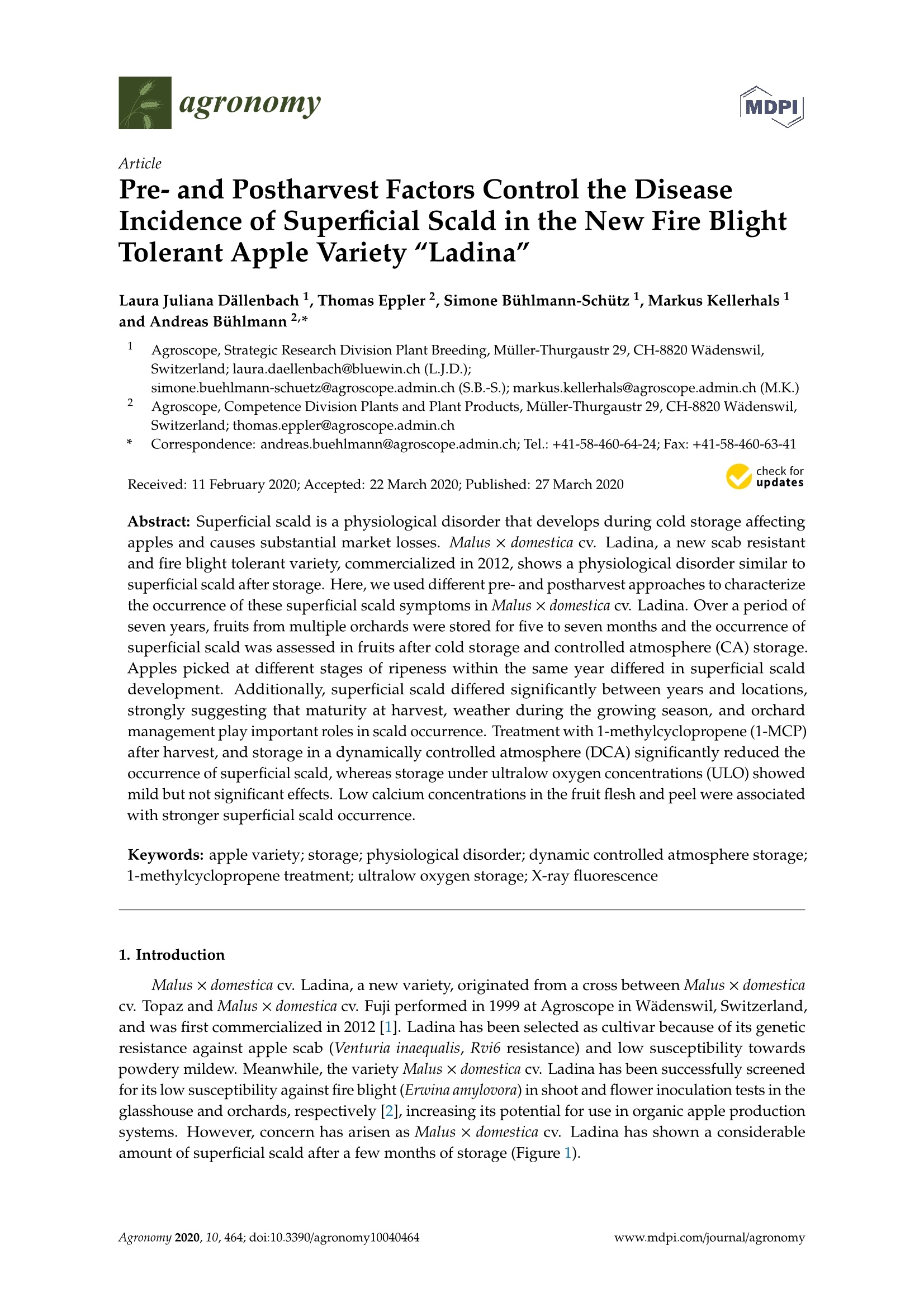
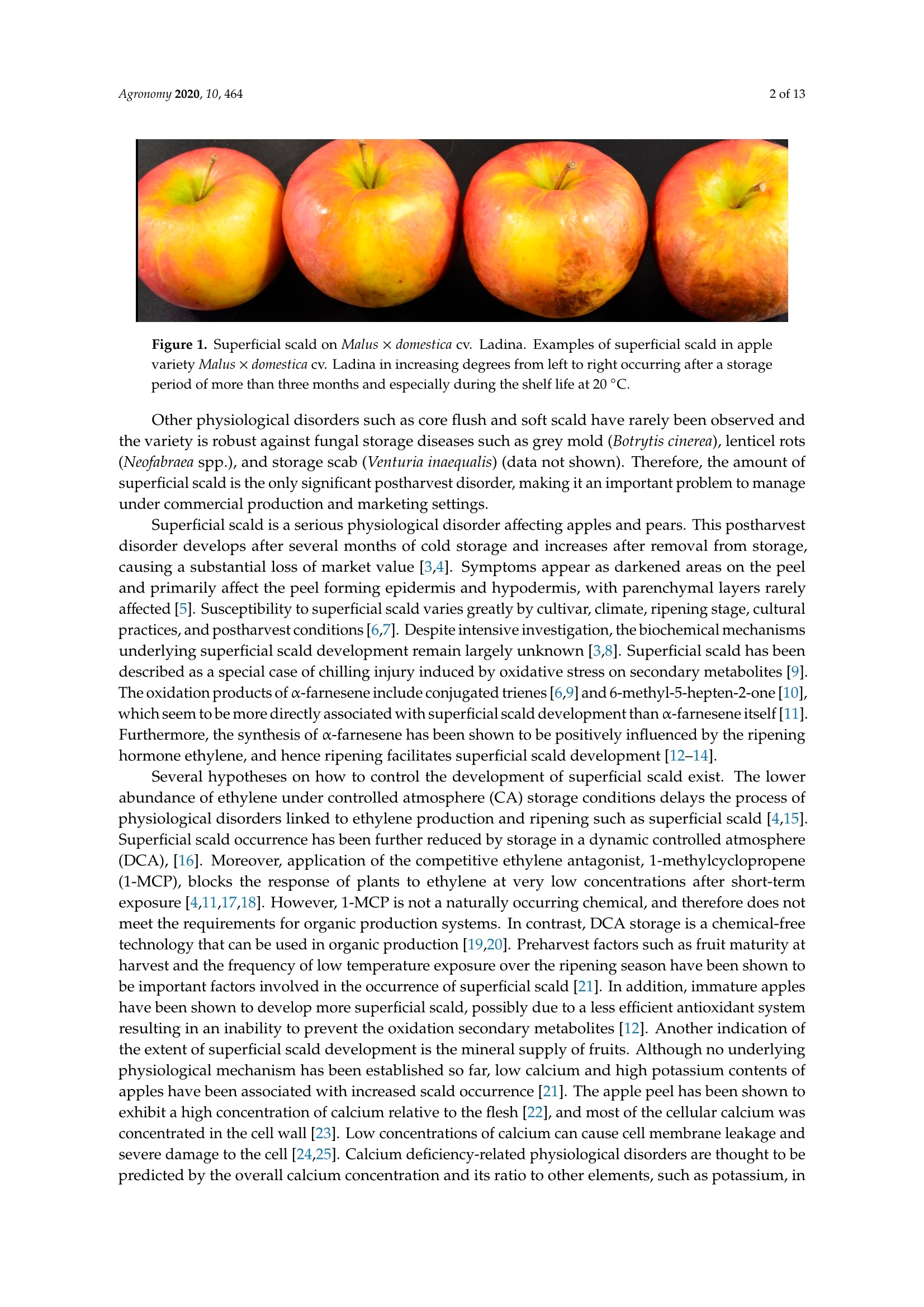
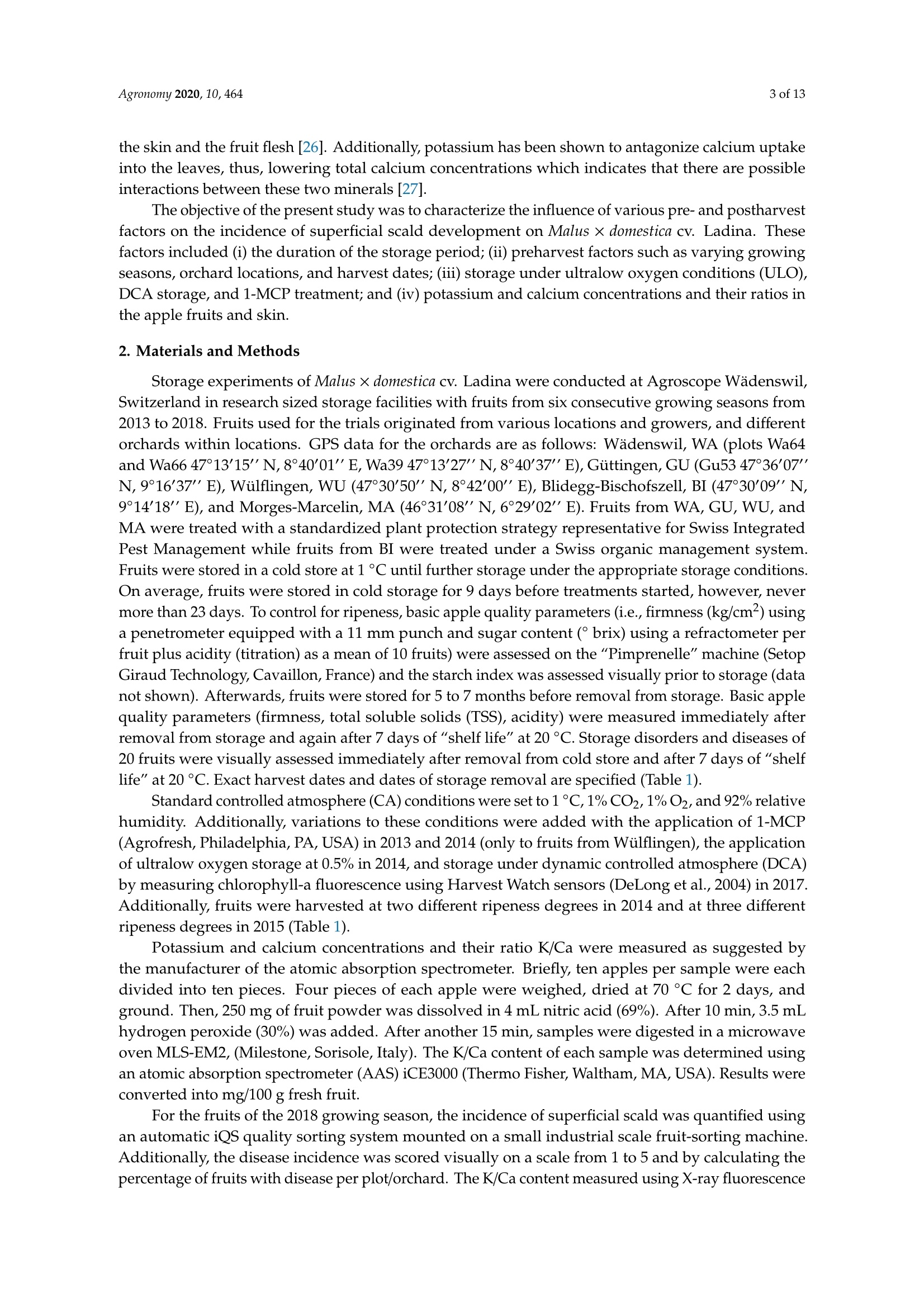
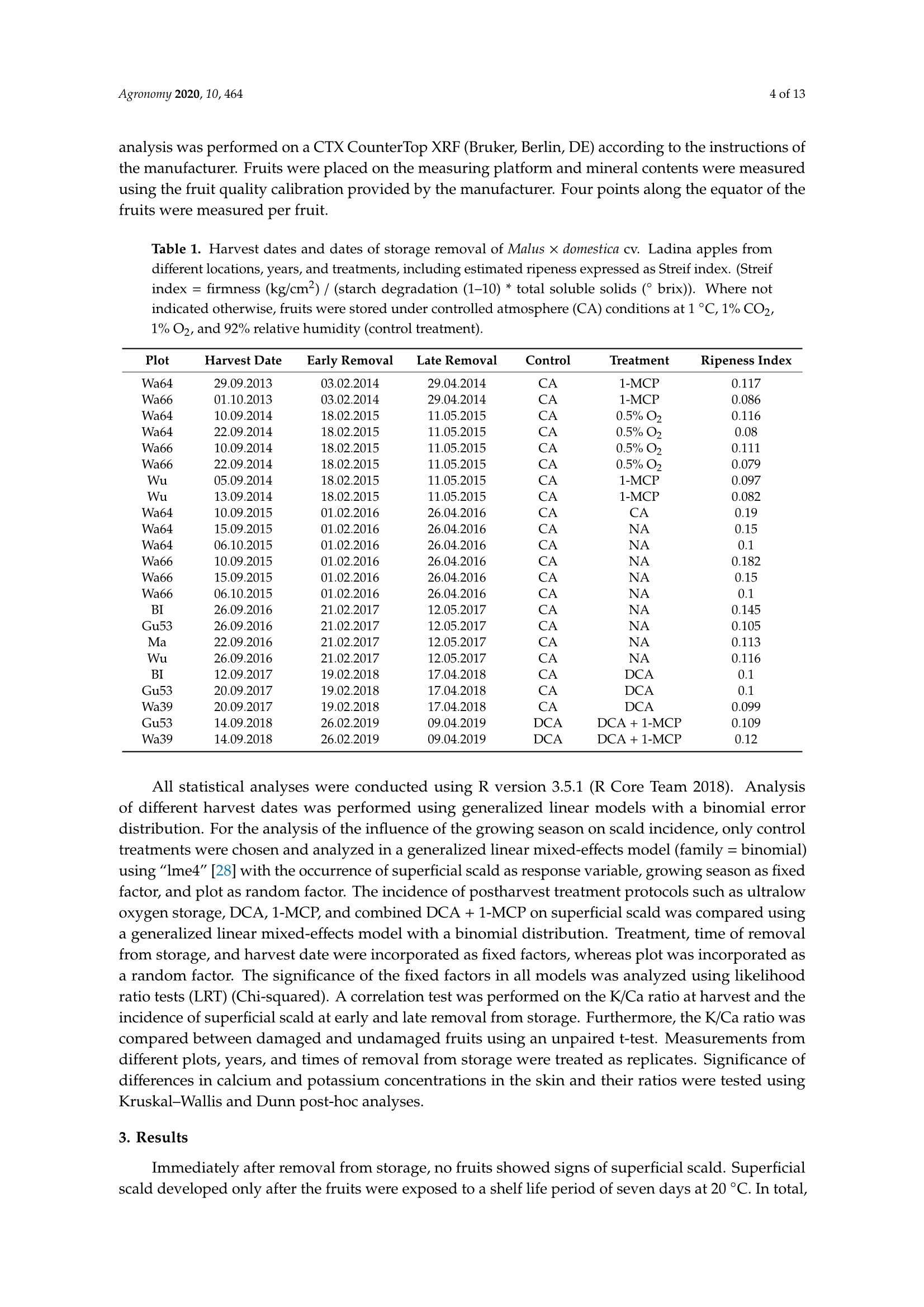
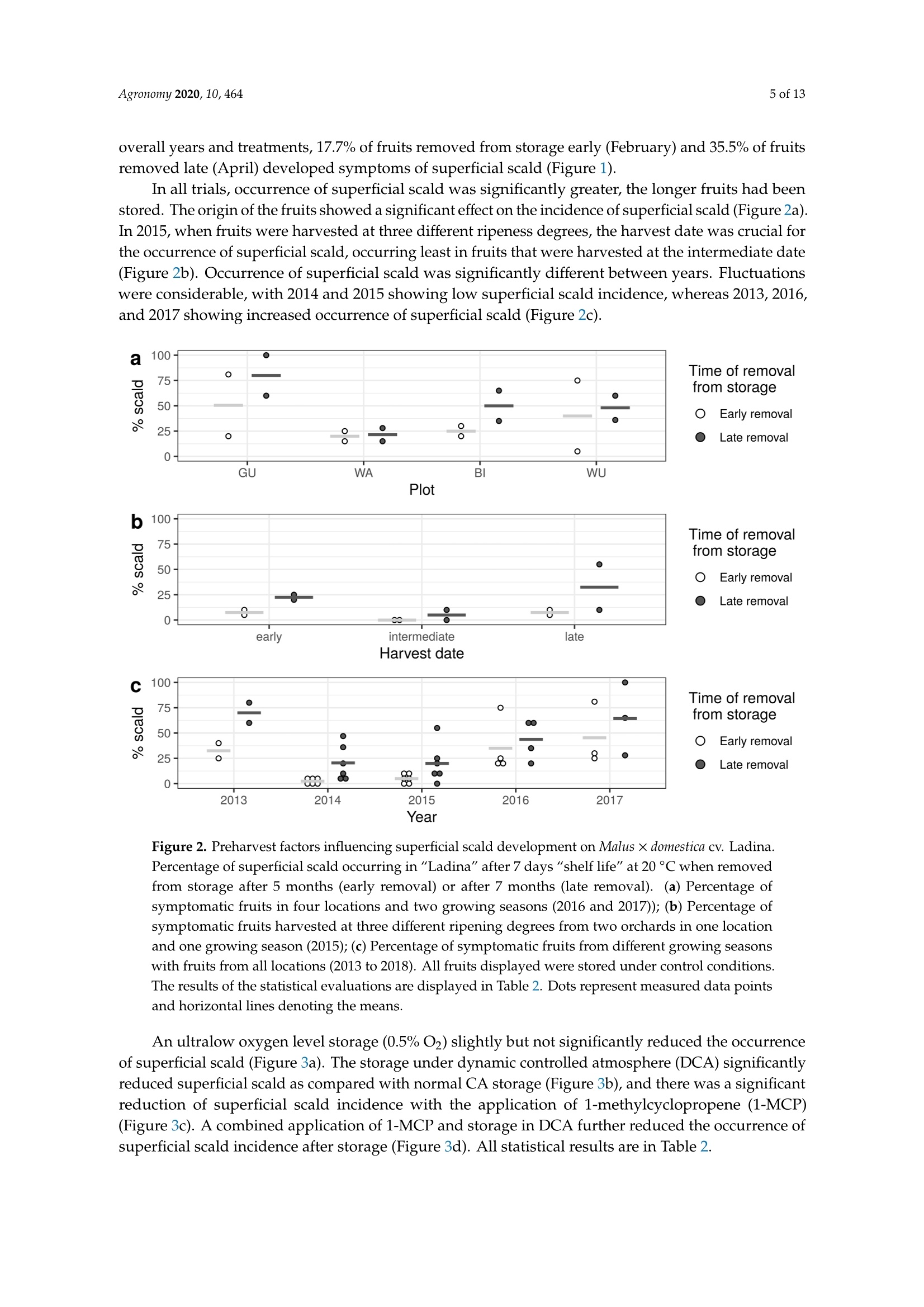
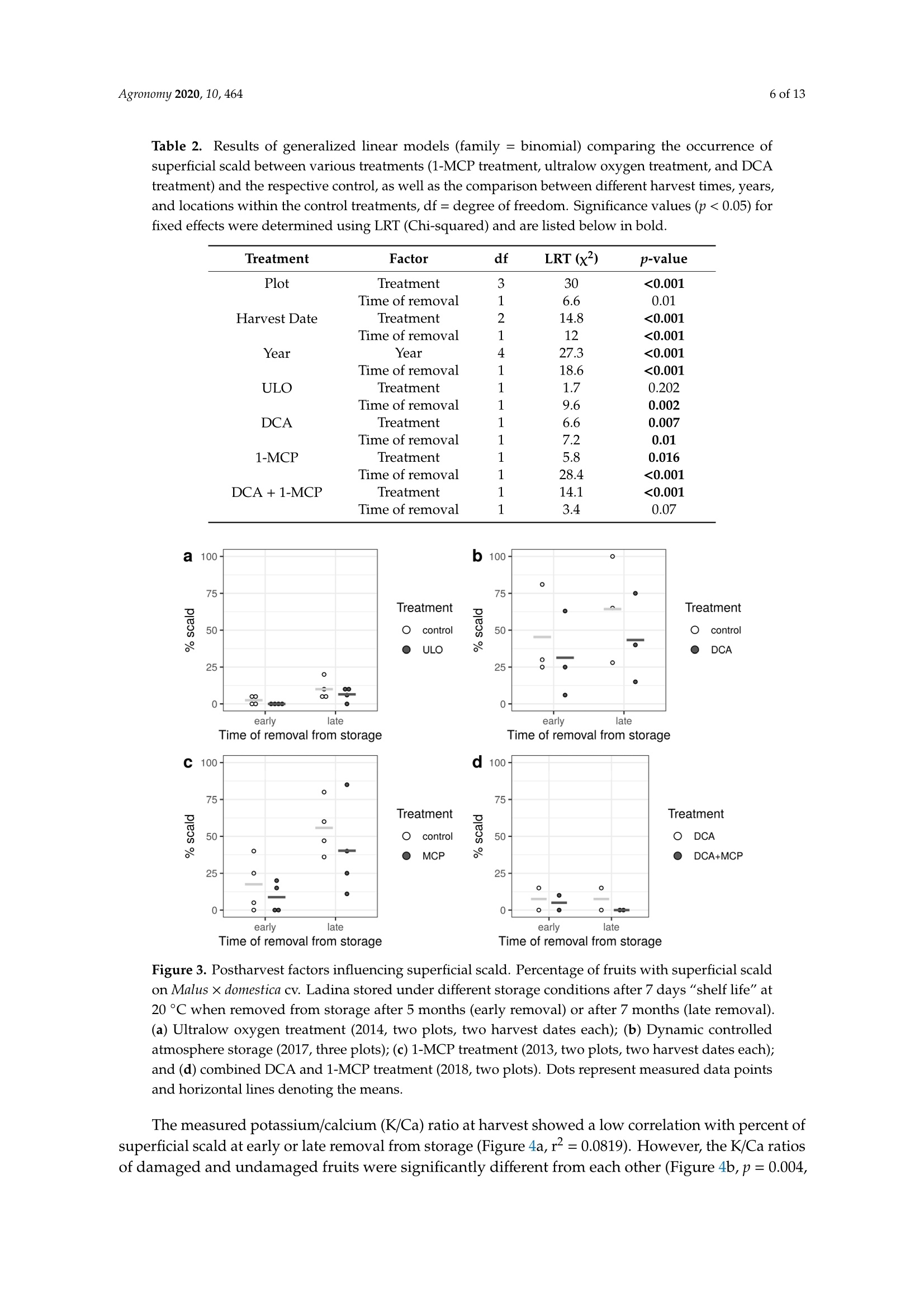
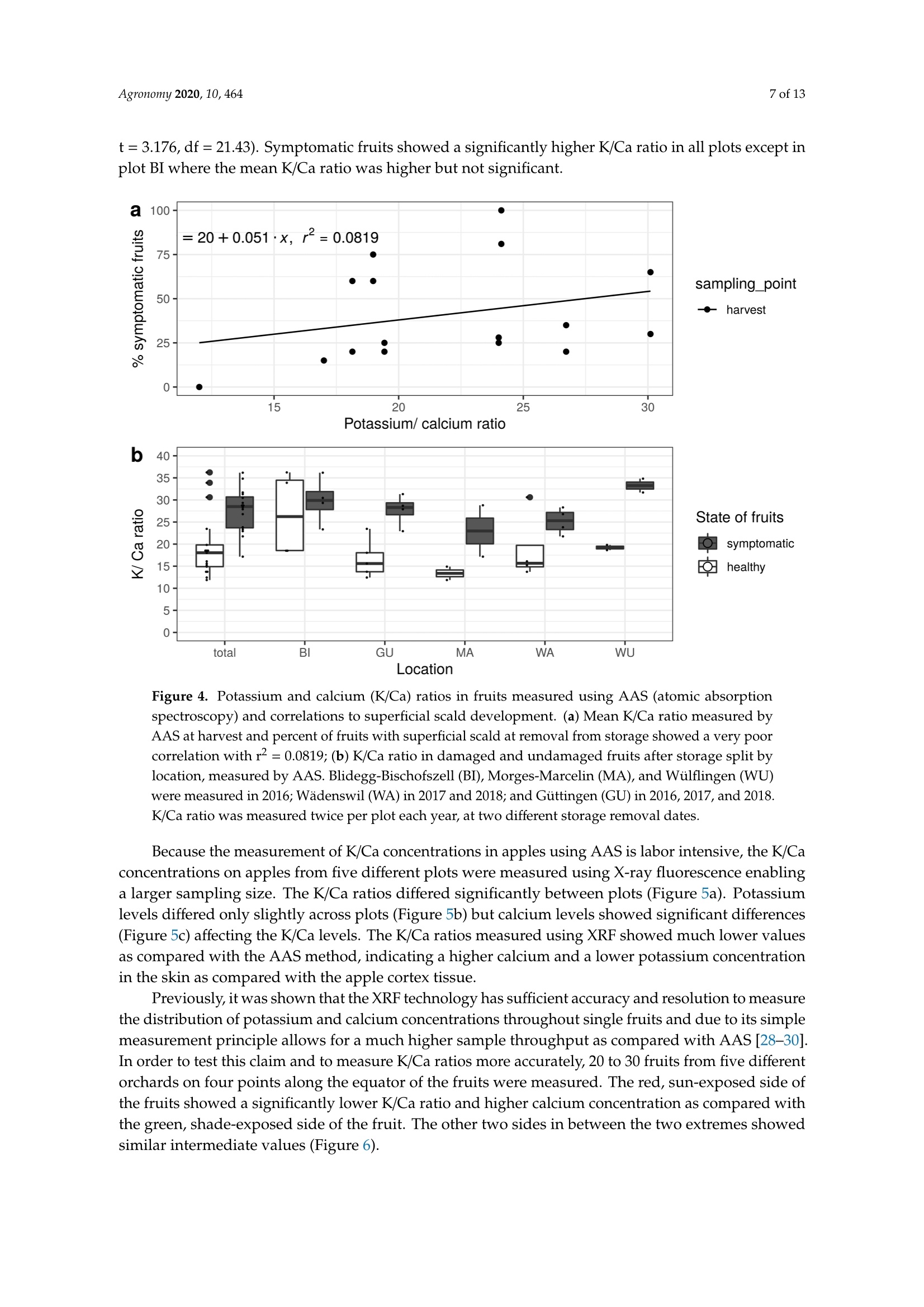
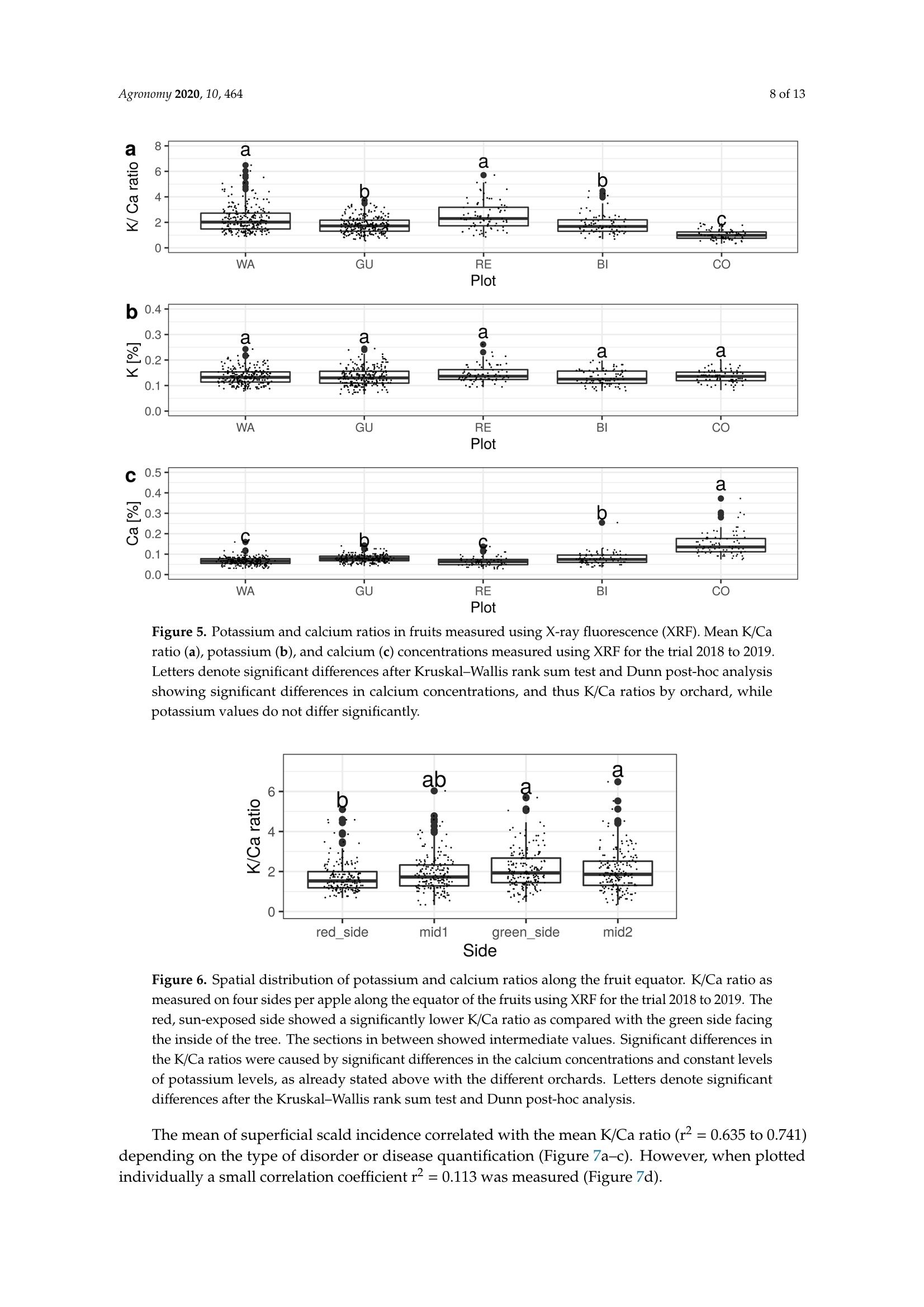
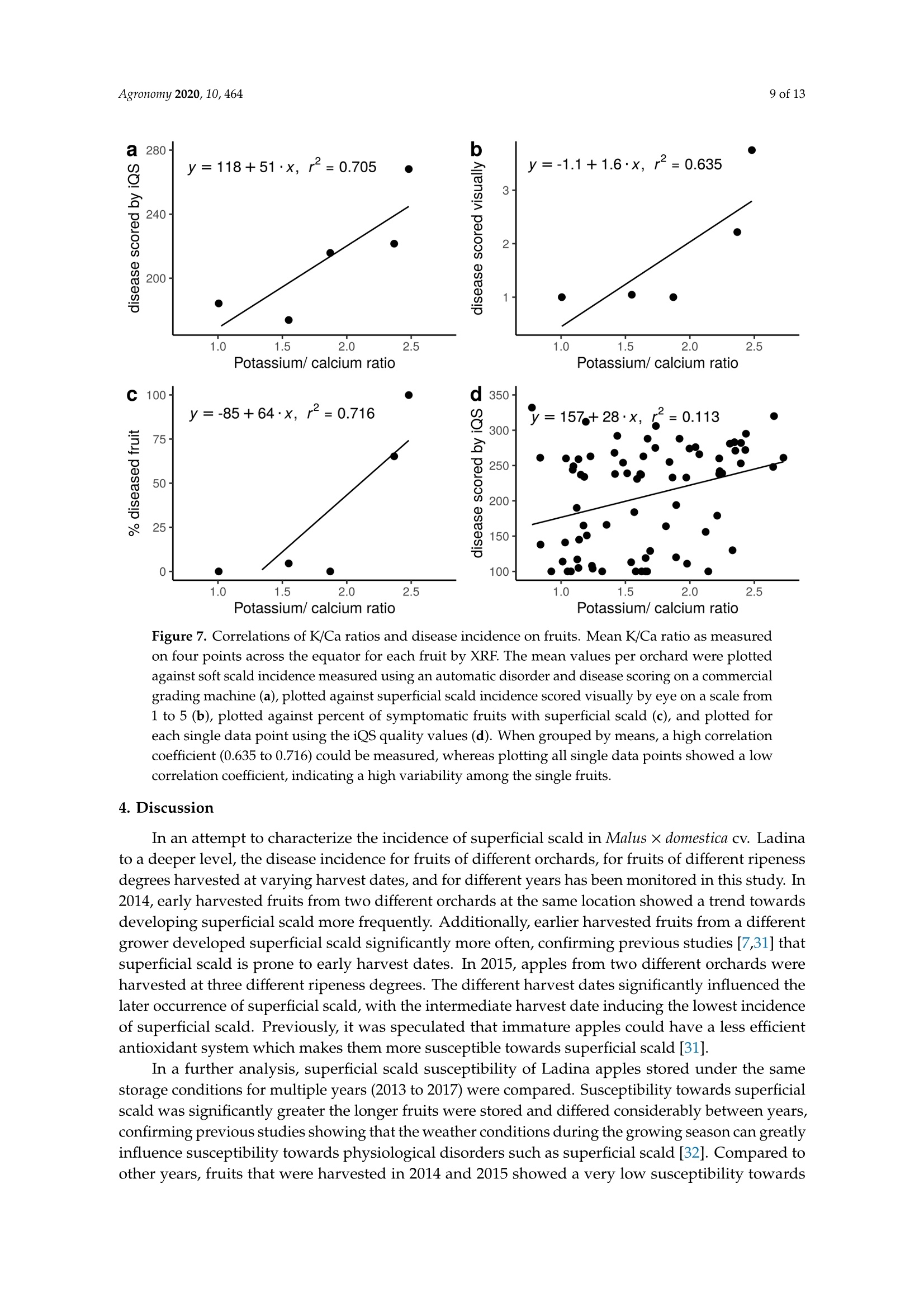
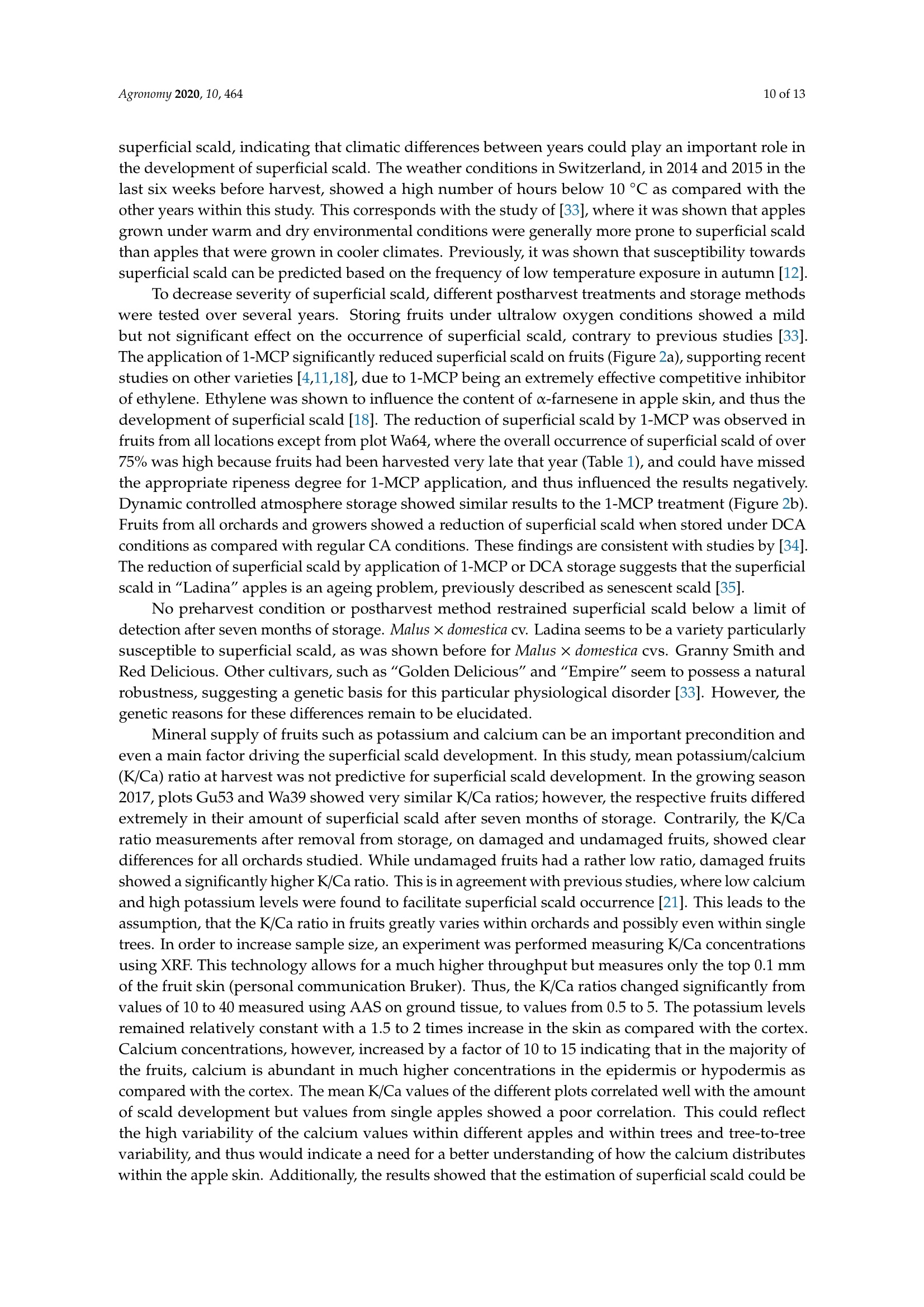
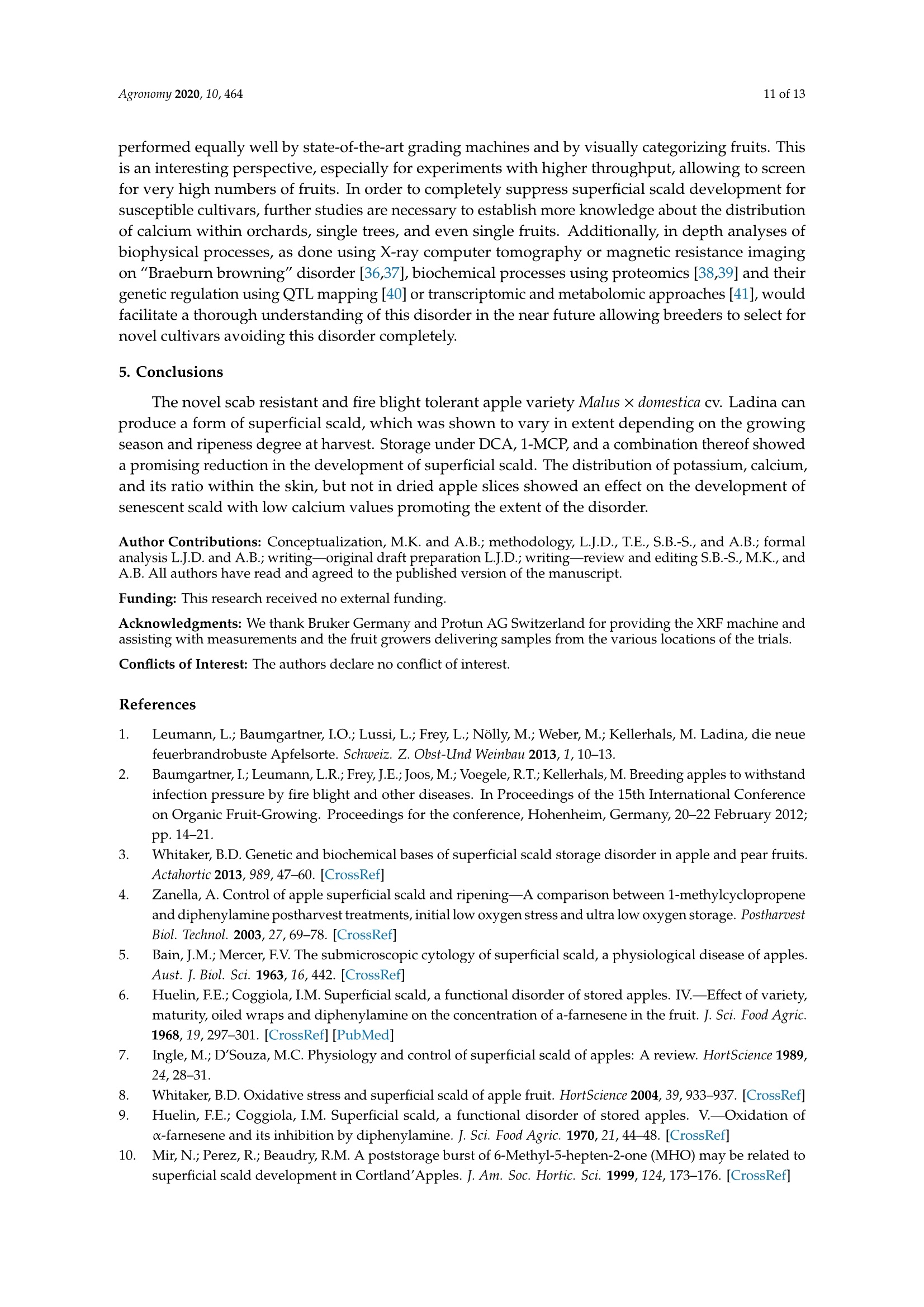
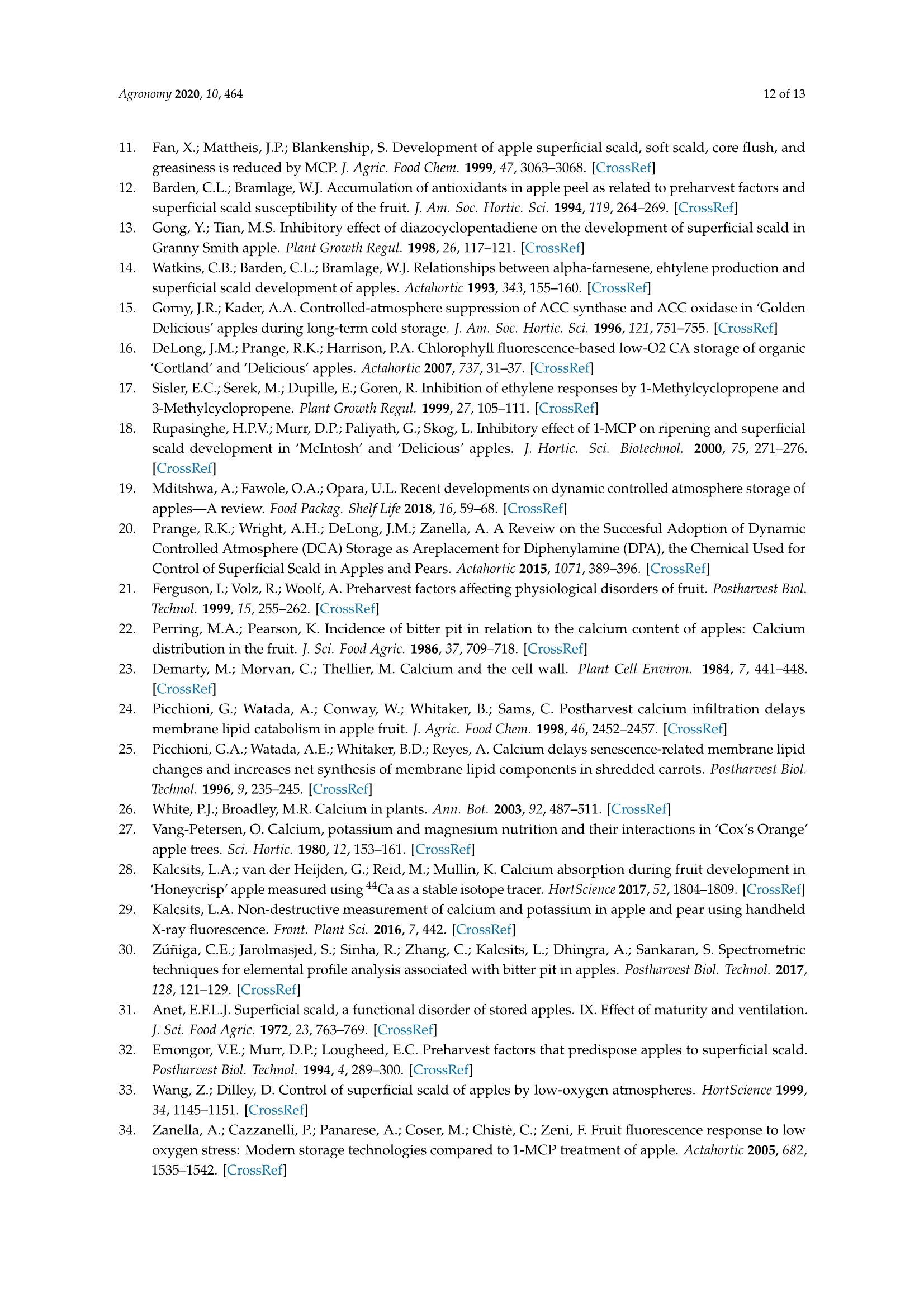
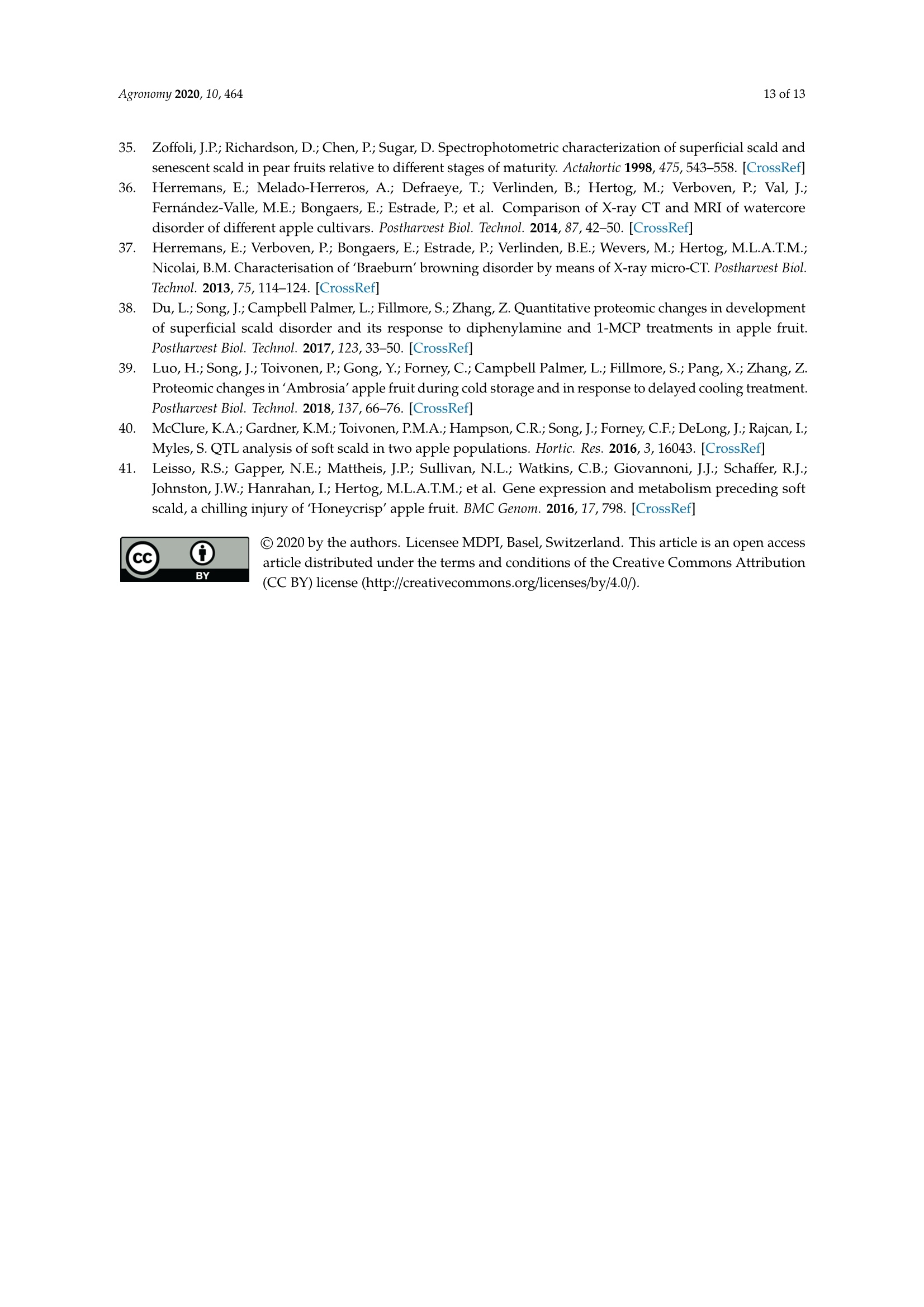
还剩11页未读,是否继续阅读?
图拉扬科技有限公司为您提供《苹果中糖度,酸度,干物质检测方案(作物无损检测)》,该方案主要用于蔬菜中营养成分检测,参考标准--,《苹果中糖度,酸度,干物质检测方案(作物无损检测)》用到的仪器有Pimprenelle全自动水果质量分选系统
相关方案
更多
该厂商其他方案
更多

